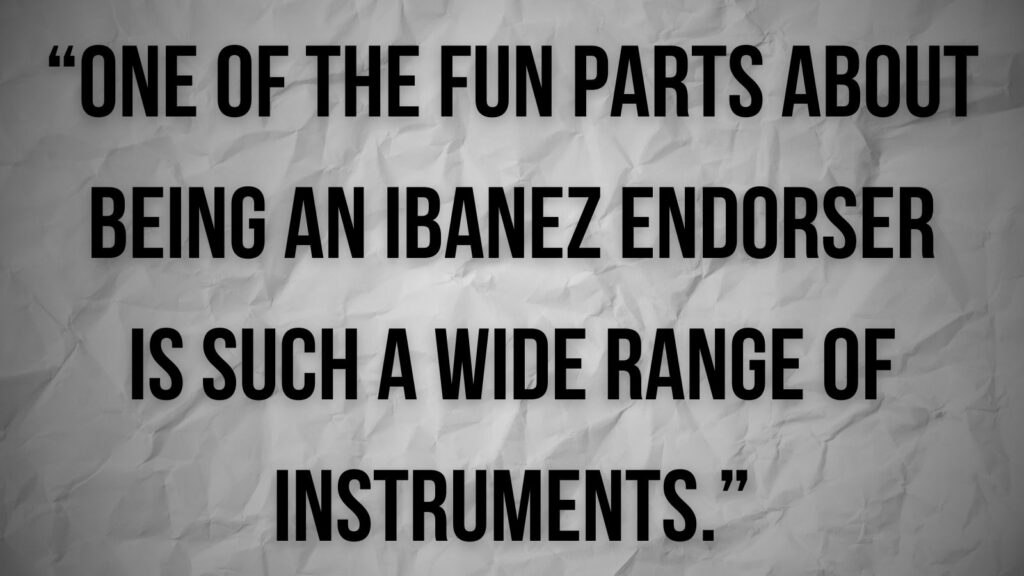Guitar virtuoso legend Paul Gilbert reflected on his long-lasting relationship with Ibanez and revealed some of the best things about being in the company’s roster of artists.
It’s not a secret that Ibanez is synonymous with classic guitar shredders. Apart from Gilbert, names associated with them include Steve Vai, Joe Satriani, Reb Beach, Frank Gambale, Lari Basilio, Nita Strauss, and many others. Interestingly enough, Gilbert is known for also using his variation to the iconic Iceman guitar, now known as FRM300. But for the most part, it’s all Super Strat-style PGM guitars, recognizable for their F-shaped color patterns, imitating violin soundholes.
Speaking to Jordi Pinyol in a recent interview, Gilbert looked back on his long collaboration with the legendary brand, explaining (transcribed by Killer Guitar Rigs):
“One of the fun parts about being an Ibanez endorser is such a wide range of instruments.”
And it’s exactly this diversity that Ibanez is very well known for. Although Gilbert brought up some partially obscure old-school models, we get what he’s saying. You’ll see these guitars in the hands of guitar players of all genres and backgrounds. He continued:
“If I want to play something like a Strat, I’ll just go back and get an Ibanez Blazer from 1981 — it’s basically a really cool made-in-Japan Strat. If I want to play something feels like a Les Paul, I’ll get a mid-90s Ghost Rider — it has a great Les Paul feel, is way less expensive, and it’s still my brand.”
“But of course, when I was a kid, a teenager, I played a Les Paul as my first electric guitar. And then also, like anybody else, I’ve got guitar heroes. For example, one of my biggest guitar heroes is Pat Travers.”
“So Pat Travers has an album cover where he’s standing on the front and he’s got a Gibson Melody Maker. It’s been modified, but it’s a Gibson Melody Maker. So I was curious. I wanted to buy one and see what it was like, so I bought it. It’s got the big sick neck, which I liked a lot.”

His current model, the Fireman, also known as FRM300, is also one of these interesting combos of the old-school and modern traits packed into one guitar. As he reveals, the inspiration also came from this thicker Melody Maker neck. Kind of unusual for a technical player like Gilbert, but it seems to work well for his playing style. He added:
“And when I asked Ibanez to make the Fireman guitar for me, they said, ‘Well, what kind of neck do you want?’ I said, ‘Well, how about like this Gibson Melody Maker?’ And so they did. So, actually, the neck on the Fireman is very influenced by the Gibson Melody Maker. I didn’t wait for the personalities of those other instruments to get into mine.”
During the interview, Gilbert also discussed how he actually improved his guitar playing and overall musical ideas by focusing on bass parts. Namely, it was Black Sabbath’s Geezer Butler and Rainbow’s and Dio’s Jimmy Bain and Rainbow’s Craig Gruber whom he had to analyze for his instrumental cover album of Dio classics. Paul offered:
“I learned a lot from learning the bass parts because when I had learned the Jimmy Bain parts and the Geezer Butler parts, one of the best ones was on ‘Man on the Silver Mountain’. The bass player was Craig Gruber. I’d never even heard of [him], but it’s almost like a disco bass line.”
“I never would have thought that was the bass part, but when I played, I was like, ‘Oh, this sounds great!’ And I’m such a better bass player now after learning all those parts.”
“And the Geezer Butler parts in Black Sabbath — those are so interesting because he rarely hits low notes. Like in ‘Heaven and Hell’: it’s a song in E, and so you think, ‘Okay, I’m gonna pick my low E string a lot’. He never hits it! He always hits it higher, like the middle E.”
“I kept waiting like, ‘Okay, at some point, he’s gonna go down and hit that low one’. And he hardly ever hits the low E. And on all the Sabbath stuff he’s like that — he really stays on the higher register. I don’t know why, but it’s a big part of his style. It really sounds cool.”
“And the Jimmy Bain stuff was just physically really demanding — ‘Stand Up and Shout’ is fast, and it just never stops. I was like, ‘My arm hurts after playing that one’. [Laughs]”
He continued:
“The bass parts also compositionally, to me, they’re smart. It’s almost like they’re a classical composer. Because as a guitar player, I always think, ‘Oh well, the bass player will just play what I play, but an octave lower’. But they don’t. They come with a whole different melody that’s going on. And it’s so cool! It’s usually more intelligent than what the guitar is doing.”
Photo: Frank Schwichtenberg (Mr. Big – Wacken Open Air 2018 21)


